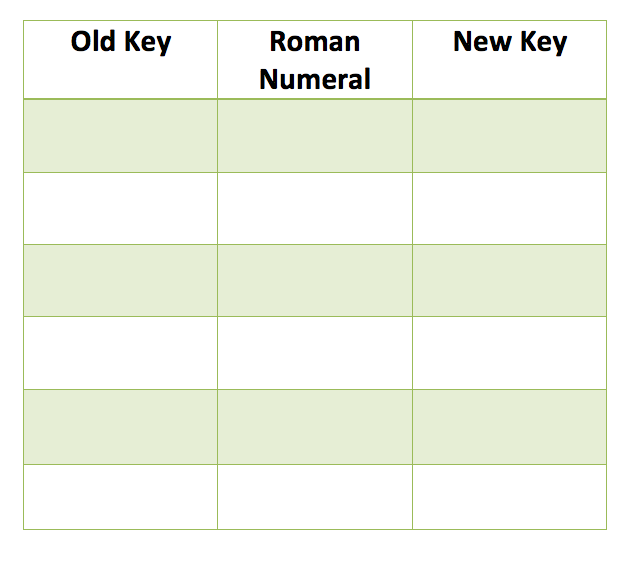
Let’s take basic chords and progressions and make them beautiful.

+
[op_liveeditor_element data-style=””][text_block style=”style_1.png” align=”left” font_size=”20″]Keep track of your progress and/or claim this for CBMT credit using the non-approved self-study option! See how by downloading the content checklist. Also – let me know when you’ve completed everything (send me a copy of the checklist) and I’ll send you a certificate of completion for the Harmonic Alchemy Skill Module.[/text_block][/op_liveeditor_element]
[op_liveeditor_element data-style=””]
 Harmonic Alchemy Content Checklist
Harmonic Alchemy Content ChecklistSend completed checklists to me at matt@musictherapysource.com for your certificate.
[/op_liveeditor_element]
[op_liveeditor_elements][/op_liveeditor_elements]

+
[op_liveeditor_element data-style=””][text_block style=”style_1.png” align=”left” font_size=”20″]
Roman Numeral Analysis
[/text_block][/op_liveeditor_element]
[op_liveeditor_element data-style=””]
[/op_liveeditor_element]
[op_liveeditor_element data-style=””][text_block style=”style_1.png” align=”left” font_size=”18″]It’s not sexy, but it IS something we need to understand if we’re going to make chords sound real pretty. Also helps a lot with transposition. Here is the chart that you see in the video: Roman Numerals[/text_block][/op_liveeditor_element]
[op_liveeditor_elements][/op_liveeditor_elements]

+
[op_liveeditor_element data-style=””][text_block style=”style_1.png” align=”left” font_size=”20″]
Transposition
[/text_block][/op_liveeditor_element]
[op_liveeditor_element data-style=””]
[/op_liveeditor_element]
[op_liveeditor_element data-style=””][text_block style=”style_1.png” align=”left”] [/text_block][/op_liveeditor_element]
[/text_block][/op_liveeditor_element]
[op_liveeditor_elements][/op_liveeditor_elements]

+
[op_liveeditor_element data-style=””][text_block style=”style_1.png” align=”left” font_size=”20″]
Using A Capo
[/text_block][/op_liveeditor_element]
[op_liveeditor_element data-style=””][text_block style=”style_1.png” align=”left” font_size=”18″]From a blog post on Music Therapy Source:
When I was a young guitarist, I used to scoff at capos.
I thought to myself: “You use a capo? What? Can’t you play barre chords?”
Barre chords ARE important, but I no longer scoff. In fact, I use a capo. Often.
Why? Because playing open chords gives me more flexibility and more options for embellishments. I also sometimes want the “open string” sound which you don’t get when barring. Furthermore, barring can get tiresome if required for the entirety of the song.[/text_block][/op_liveeditor_element]
[op_liveeditor_element data-style=””]
[/op_liveeditor_element]
[op_liveeditor_element data-style=””][text_block style=”style_1.png” align=”left” font_size=”18″]SO: I hereby give you permission to use a capo when appropriate. You just have to know how to use it effectively. Watch the video to see what I mean about options and embellishments. Our goal is to use the guitar capo as a tool, not a crutch.
You should also check out my free resource, The Capo Converter, which makes transpositions with the capo VERY easy.
My favorite guitar capo is made by Kyser, and I’ve had many of them. They’ve always been durable, and I’ve only replaced them because I’ve lost them at gigs or camping trips.
For those who aren’t familiar with capos, they are simply clamp-like tools that allow you to transpose the entire guitar by depressing all the strings at a single fret. This essentially creates a new nut.
There are two primary reasons for using a capo, and a third hybrid which basically just combines the first two.
Reason 1 for using a capo: same shapes, easier key.
The first is to maintain chord shapes but change the key. For example, let’s say you’re playing a song in G that uses the chords G-C-Am-D. You decide it’s a bit too low for your (or your client’s) range. Perhaps it would sit best in the key of Bb.
Post-transposition, the chords are Bb-Eb-Cm-F, which are all barre chords if you’re playing in standard tuning.
The capo allows us to use the same shapes as before if we place it at the 3rd fret. Essentially, we are moving the nut up by 3 semitones.
In another example, lets say you’re playing a song in D, using the chords D-G-Em-A7. Suppose you would rather play it in E but you prefer to use D shapes because it’s what you’ve practiced and what you have memorized. To use the same shapes, you need to “move the nut” up 2 semitones, which is accomplished by placing the capo on the 2nd fret.
Side note: this doesn’t work as well if you’re trying to transpose DOWN by anything less than about 5 semitones or UP by more than 6 or 7 semitones. If you’re trying to put the capo anywhere above the 7th fret, things can start to sound pretty tinny.
Reason 2 for using a capo: same key, easier shapes.
The second situation in which we can use a capo is if a song is in a difficult key and we can use it to make it easier to play with open chord shapes. So this doesn’t involve transposition, at least not directly.
Imagine your client wants to sing a song in the key of Eb. It contains the chords Eb-Cm-Fm-Bb. Yikes – that’s a lot of barre chords.
But we can use a capo to easily play these chords as open chords. If we think about this progression, it’s a I-vi-ii-V. What open keys are especially easy with regard to this progression? Well, it’s pretty easy in both the keys of G and C.
If we wanted to use our G shapes (G-Em-Am-D), we would have to put the capo waaaay up on the 8th fret so that the root of the I chord (G shape) is at the 11th fret. Welcome to Tinny Town.
HOWEVER, if we look at where the capo would have to go in order to play C shapes, it’s not so bad. If we put it on fret 3, we can play C-Am-Dm-G.
Reason 3 for using a capo: easier shapes, easier key.
The final is just a hybrid of the first two, where you are both changing the key and the shapes. If a song is originally in Db but you want to sing it in B, you would first think about where your B’s are on the lowest bass strings (E and A). I know this is getting tricky. Try to visualize this in your head or grab a guitar and stick with me.
You have a B at the 7th fret on the low E string, or on the 2nd fret of the A string. That gives you the following options:
Capo at 2nd fret and play A shapes (I-IV-V = A-D-E)
Capo at 7th fret and play E shapes (I-IV-V7=E-A-B7)
Capo at 4th fret and play G shapes (I-IV-vi-ii-V7=G-C-Em-Am-D7)
The third option gives us the most open shapes to use, so this is probably what I would choose.
Make sense?
[/text_block][/op_liveeditor_element]
[op_liveeditor_elements][/op_liveeditor_elements]

+
[op_liveeditor_element data-style=””][text_block style=”style_1.png” align=”left” font_size=”20″]
The Capo Converter
[/text_block][/op_liveeditor_element]
[op_liveeditor_elements][/op_liveeditor_elements]

+
[op_liveeditor_element data-style=””][text_block style=”style_1.png” align=”left” font_size=”20″]
Pivots
[/text_block][/op_liveeditor_element]
[op_liveeditor_element data-style=””]
[/op_liveeditor_element]
[op_liveeditor_elements][/op_liveeditor_elements]

+
[op_liveeditor_element data-style=””][text_block style=”style_1.png” align=”left” font_size=”20″]
Add 9 (or Sus 2) Chords
[/text_block][/op_liveeditor_element]
[op_liveeditor_element data-style=””]
[/op_liveeditor_element]
[op_liveeditor_elements][/op_liveeditor_elements]

+
[op_liveeditor_element data-style=””][text_block style=”style_1.png” align=”left” font_size=”20″]
Major 7 Chords
[/text_block][/op_liveeditor_element]
[op_liveeditor_element data-style=””]
[/op_liveeditor_element]
[op_liveeditor_elements][/op_liveeditor_elements]


+
[op_liveeditor_element data-style=””][text_block style=”style_1.png” align=”left” font_size=”20″]
Sus and 7sus Chords
[/text_block][/op_liveeditor_element]
[op_liveeditor_element data-style=””]
[/op_liveeditor_element]
[op_liveeditor_elements][/op_liveeditor_elements]

+
[op_liveeditor_element data-style=””][text_block style=”style_1.png” align=”left” font_size=”20″]
Harmonic Enhancements in G
[/text_block][/op_liveeditor_element]
[op_liveeditor_element data-style=””]
[/op_liveeditor_element]
[op_liveeditor_elements][/op_liveeditor_elements]

+
[op_liveeditor_element data-style=””][text_block style=”style_1.png” align=”left” font_size=”20″]
Harmonic Enhancements in C
[/text_block][/op_liveeditor_element]
[op_liveeditor_element data-style=””]
[/op_liveeditor_element]
[op_liveeditor_elements][/op_liveeditor_elements]

+
[op_liveeditor_element data-style=””][text_block style=”style_1.png” align=”left” font_size=”20″]
Harmonic Enhancements in D
[/text_block][/op_liveeditor_element]
[op_liveeditor_element data-style=””]
[/op_liveeditor_element]
[op_liveeditor_elements][/op_liveeditor_elements]

+
[op_liveeditor_element data-style=””][text_block style=”style_1.png” align=”left” font_size=”20″]
More Examples
AMTA 2015: Sound Better, Work Less
[/text_block][/op_liveeditor_element]
[op_liveeditor_element data-style=””]
[/op_liveeditor_element]
[op_liveeditor_elements][/op_liveeditor_elements]

+
[op_liveeditor_element data-style=””][text_block style=”style_1.png” align=”left” font_size=”20″]
Color Chord My World:
10 Chord Progressions For Learning And Relaxation
[/text_block][/op_liveeditor_element]
[op_liveeditor_element data-style=””]
 Color Chord My World
Color Chord My WorldDownload this then watch the video for examples.
[/op_liveeditor_element]
[op_liveeditor_element data-style=””]
[/op_liveeditor_element]
[op_liveeditor_elements][/op_liveeditor_elements]
